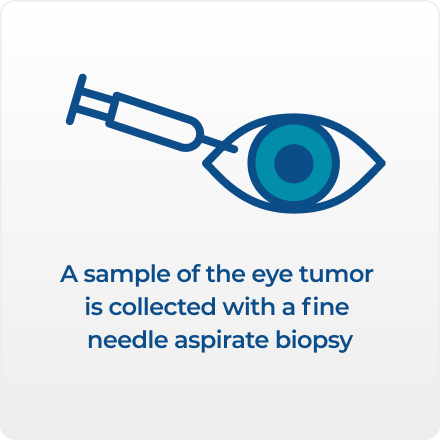Know Your Metastatic Risk
Utilizing advanced testing to understand the likely course of a disease
The goal of genomic testing is to understand how genes influence tumor behavior. Although it is a relatively young and evolving field, genome-based medicine, frequently called personalized medicine, is the future of healthcare—the next logical step in which what we know about human genetics, disease and wellness can be applied to improve patient care.
Personalized medicine promises to make treatment as individualized as the disease. It involves translating genetic, genomic and clinical information into precise diagnostic tests and targeted therapies. Advances in this area of science are also opening the door to far more accurate predictive tests for cancers that allow doctors to better treat and prepare their patients for the most likely course of their disease.
For uveal melanoma, a potentially aggressive eye cancer, there is a test called DecisionDx-UM that examines your eye tumor at the molecular level, and predicts with a high degree of accuracy the likelihood it will metastasize or spread to other parts of the body. The accuracy of the DecisionDx-UM test is unparalleled in the prognostic testing of uveal melanoma.
Getting tested: timing is important
The eye tumor biopsy must be taken before radiation
Once you have been diagnosed with primary uveal melanoma, if you choose to know your metastatic risk, a critical aspect is the timing involved in sampling your tumor. If you’re newly diagnosed, your doctor may already be discussing treatment of the eye tumor, in the majority of cases (80-90%) with some form of radiation therapy.

Once tumor tissue has been exposed to radiation, the test’s ability to provide meaningful results may be compromised. For this reason, the test cannot be run on radiated tissue. It is extremely important to have a discussion about the test with your treating doctor in the short window of time before radiation therapy (see “Talk to Your Doctor”).
Timing is not a critical issue if the treatment plan is enucleation, or removal of the eye. In this case, tissue can be collected by needle biopsy right after the eye has been removed, or later, from the paraffin (a kind of wax) tissue block of the eye that is made following surgery, as is standard practice.

There is often a very short period of time between diagnosis and radiation treatment – and the tumor tissue sample required for DecisionDx-UM test must be taken prior to radiation therapy.
The benefits of knowing your metastatic risk
Patients want to know what the future holds
If you’ve just been diagnosed with uveal melanoma, it’s important to know that there is a test that can accurately identify your tumor type or class. Specifically, the test determines whether you are at low or high risk of the cancer spreading even after your eye tumor has been successfully treated.
The test is called DecisionDx-UM, and it provides valuable information to help you and your healthcare team individualize the management of your disease. Validated in two prospective multi-center studies, as well as additional prospective and retrospective studies, the test is the most accurate prognostic test available for uveal melanoma.
One of the objectives of this website is to provide the information you need to decide with your healthcare team whether this test is right for you.
Getting tested is ultimately your choice – and no one else's.
The benefits of knowing your tumor molecular class
There are immediate benefits to knowing your tumor's molecular class, including the ability for you and your healthcare team to define the intensity of your monitoring and follow-up plans. While everyone hopes to land in the lowest risk group, most patients report that the information is extremely valuable to them, no matter the results.
The information provided by the test helps healthcare providers know which patients require the most rigorous monitoring to catch and treat metastatic disease early. Up to half of all uveal melanoma patients may ultimately develop metastatic disease, most commonly to the liver, after which prognosis is usually poor. The hope is that intensive monitoring may lead to early detection of metastatic disease and immediate treatment that could produce better outcomes for the patient.
Many people with uveal melanoma report other benefits of knowing their metastatic risk, including “peace of mind” and “ability to make plans” for themselves and their families. Studies have shown that most patients will choose to know their risk if they have the information and the opportunity is made available to them.


